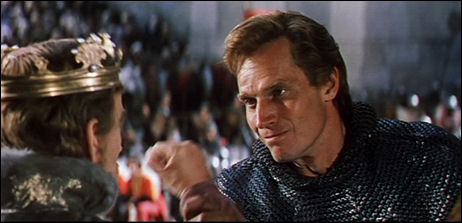“Charlton Heston is an axiom. He constitutes a tragedy in himself, his presence in any film being enough to instill beauty. The pent-up violence expressed by the somber phosphorescence of his eyes, his eagle’s profile, the imperious arch of his eyebrows, the hard, bitter curve of his lips, the stupendous strength of his torso — this is what he has been given, and what not even the worst of directors can debase.

“It is in this sense that one can say that Charlton Heston, by his very existence and regardless of the film he is in, provides a more accurate definition of the cinema than films like Hiroshima mon amour or Citizen Kane, films whose aesthetic either ignores or repudiates Charlton Heston. Through him, mise en scene can confront the most intense of conflicts and settle them with the contempt of a god imprisoned, quivering with muted rage.” — French film critic Michel Mourlet, from a 1960 Cahiers du Cinema essay, quoted today by both Time‘s Richard Corliss and Dave Kehr on his own film blog (i.e., not his Times DVD column).

